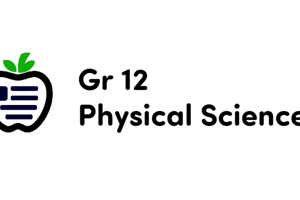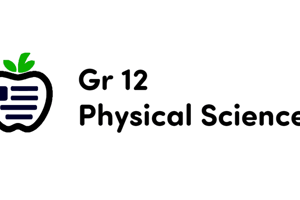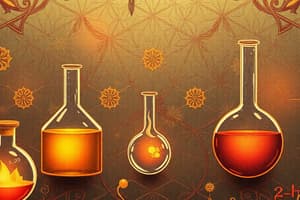Podcast
Questions and Answers
At which condition will the dissociation of acetic acid be suppressed?
At which condition will the dissociation of acetic acid be suppressed?
- Increasing the concentration of H<sup>+</sup> ions (correct)
- Decreasing the concentration of H<sup>+</sup> ions (correct)
- Decreasing the concentration of CH<sub>3</sub>COO<sup>-</sup> ions (correct)
- Decreasing both concentrations of H<sup>+</sup> and CH<sub>3</sub>COO<sup>-</sup> ions (correct)
What is the oxidation number of sodium in sodium chloride (NaCl)?
What is the oxidation number of sodium in sodium chloride (NaCl)?
- 0
- +1 (correct)
- -1
- +2
Which compound was first synthesized by F.Wohler in 1828?
Which compound was first synthesized by F.Wohler in 1828?
- Benzene
- Urea (correct)
- Methane
- Acetic acid
Which of the following correctly arranges the compounds in the increasing order of their boiling points?
Which of the following correctly arranges the compounds in the increasing order of their boiling points?
What is the term for the reaction where alkenes are prepared from vicinal dihalides using zinc?
What is the term for the reaction where alkenes are prepared from vicinal dihalides using zinc?
What is the SI unit of temperature?
What is the SI unit of temperature?
What is the term for the number of moles of solute present in one litre of solution?
What is the term for the number of moles of solute present in one litre of solution?
Which pair represents isobars?
Which pair represents isobars?
What is the correct order of atomic/ionic radii for sodium atom (Na) and sodium ion (Na+)?
What is the correct order of atomic/ionic radii for sodium atom (Na) and sodium ion (Na+)?
Which angle corresponds to sp² hybridization?
Which angle corresponds to sp² hybridization?
Flashcards
What is the SI unit of temperature?
What is the SI unit of temperature?
Kelvin (K).
What is molarity?
What is molarity?
Molarity is the number of moles of solute dissolved per liter of the solution.
What are isobars?
What are isobars?
Isobars are atoms of different elements with the same mass number but different atomic numbers.
Compare the radii of Na and Na+.
Compare the radii of Na and Na+.
Signup and view all the flashcards
What is the bond angle for sp² hybridization?
What is the bond angle for sp² hybridization?
Signup and view all the flashcards
What does it mean for a reaction to be 'spontaneous at all temperatures'?
What does it mean for a reaction to be 'spontaneous at all temperatures'?
Signup and view all the flashcards
What is the relationship between [H3O+] and [OH-] in an acidic solution?
What is the relationship between [H3O+] and [OH-] in an acidic solution?
Signup and view all the flashcards
How does increasing the concentration of H+ ions affect the dissociation of acetic acid?
How does increasing the concentration of H+ ions affect the dissociation of acetic acid?
Signup and view all the flashcards
What is the oxidation number of sodium in sodium chloride (NaCl)?
What is the oxidation number of sodium in sodium chloride (NaCl)?
Signup and view all the flashcards
What compound is responsible for the Prussian blue color in the Lassaigne's test for nitrogen?
What compound is responsible for the Prussian blue color in the Lassaigne's test for nitrogen?
Signup and view all the flashcards
Study Notes
Chemistry Exam Information
- Exam duration: 3 hours 15 minutes
- Total questions: 52
- Maximum marks: 70
- Exam parts: 5 (A, B, C, D, E)
- All parts are compulsory
Instructions
-
All parts are compulsory
-
Write balanced chemical equations and diagrams where needed
-
For numerical problems, detailed steps and units are required for marks
-
Scientific calculators are not allowed, log tables and simple calculators allowed
-
Part A: 20 marks, 1 mark per question, first attempted answer considered
-
Part B: 10 marks, 2 marks per question
-
Part C: 18 marks, 3 marks per question
-
Part D: 10 marks, 5 marks per question
-
Part E: 12 marks, 3 marks per question
Part A - Multiple Choice
- Unit for temperature: Kelvin (K)
- Number of moles of solute per liter of solution: Molarity
- Isobars: 12C and 13C, 35Cl and 37Cl, 14C and 14N
Other Questions
- Lassaigne's test for nitrogen: Prussian blue color from Na₄[Fe(CN)₆]
- First organic compound synthesized by Wohler in 1828: Urea
- Increasing boiling points (Least to Greatest): 2,2-dimethylpropane < 2-methylbutane < Pentane
- Reaction for preparing alkenes from vicinal dihalides: Dehalogenation
- Bond order in oxygen molecule (O₂): 2
- pH of a solution is 10, pOH is 4
- Position isomer of propan-1-ol (C₃H₈O): Propan-2-ol
- Addition of HBr to propene: 2-bromopropane
- Open system examples: Open containers, chemical reactions in the atmosphere, biological systems
- Define buffer solutions and examples
- Define isoelectronic species and an example pair: F-, Li+, O²-, H+
- Dipole moment of BeF₂: Zero
- Stronger bonds: σ bonds
- Differences between Bonding and Antibonding molecular orbitals: BMO are lower in energy, ABMO are higher in energy, BMO bonding orbitals, and ABMO antibonding orbitals (different properties / behaviors)
- Stock notation examples: CuI, Fe₂O₃
- Nucleophiles: Species that have a lone pair of electrons to donate, examples various
- Wurtz Reaction to prepare ethane reaction formula
- Electron gain enthalpy across a period and down a group (trend): trend increase and decrease
- Types of hydrogen bonding: Intermolecular forces, intermolecular hydrogen bond formation
- Electronic configuration and bond order of H₂ molecule
- Magnetic property of H₂ molecule: Diamagnetic
- sp Hybridisation example: BeCl₂
- Oxidation number of sodium in sodium chloride: +1
- Specific heat measurement: Bomb calorimeter
- Le Chatelier's principle: shift equilibrium
- Conjugate acid-base pairs: NH₄⁺ (conjugate acid of NH₃), OH⁻ (conjugate base of H₂O)
- Detecting carbon and hydrogen in an organic compound (CuO method)
- Methods for purifying organic compounds
- Resonance effect (+R, -R): Electron donating, electron withdrawing groups
- Species formed during homolytic and heterolytic cleavage of covalent bonds
- Structure for conformations (eclipsing / staggered) of ethane
- Preparation of acetylene (ethyne) from calcium carbide
- Mechanism of benzene nitration
- Reaction products (A & B) using various reagents and conditions
- Empirical formula for iron oxide (Fe₂O₃)
- Mass percentage of elements in carbon dioxide (CO₂)
- Energy of one mole of photons: Given frequency and h constant (Planck's constant), and Avogadro's number
- Uncertainty in velocity measurement (given mass of electron and distance)
- Standard enthalpy of combustion of benzene (given equations)
- Calculations of ΔG, spontaneity and predicting if reaction will be spontaneous or not (using thermodynamic data)
- Dissociation constant for conjugate base of HF -Equilibrium constant Kp calculations for reaction involving gasses (using R and T data)
Studying That Suits You
Use AI to generate personalized quizzes and flashcards to suit your learning preferences.
Related Documents
Description
This quiz provides comprehensive information about the chemistry exam format, including details on each part and the types of questions to expect. It covers essential topics such as writing balanced chemical equations, understanding molarity, and key chemical principles needed for effective preparation.



